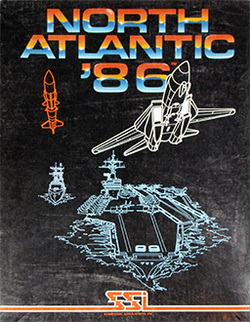- North Atlantic '86
-
North Atlantic '86 
Cover artDeveloper(s) Gary Grigsby Publisher(s) Strategic Simulations, Inc.[1] Platform(s) Apple II Release date(s) Genre(s) Strategy[1] Mode(s) Single-player North Atlantic '86 was a computer war game covering a hypothetical conflict between NATO and the Soviet Union. Written by game author Gary Grigsby and published by Strategic Simulations, Inc. it ran on the Apple II platform.
The game used the same basic program used by Grigsby's previous Guadalcanal Campaign and Bomb Alley, which were coded in the Applesoft BASIC language. Each turn represented twelve hours, but in North Atlantic '86 air and land combat could also take place at night instead of only during daytime turns. There were many other additional features, such as electronic warfare, missile attacks, and the ability to conduct multiple paratroop drops. The most important was the ability to not only overrun enemy bases, but use them after a short delay. This made the possession of Iceland especially valuable.
As in the previous two games, an AI "player" was available for one side only: the Soviets. NATO had to have a human player.
The game assumed that Warsaw Pact forces had successfully overrun most of Western Europe. The Soviets' next goal was to close the North Atlantic and starve Britain. Conversely, NATO was required to keep Britain supplied, primarily with ship convoys. The game assumed both sides would restrict the use of nuclear weapons to anti-submarine weapons only. There were four scenarios ranging from one convoy to Britain, up to a full campaign of several months.
Game details
There was one interesting thing missing as compared to Guadalcanal Campaign and Bomb Alley. In the WWII games, Grigsby had kept track of the number of torpedoes carried on each ship and submarine. But the need to keep track of so many other variables in North Atlantic '86 caused him to delete the counters and instead give each ship a random chance of exhausting its stock of torpedoes each time it fired. This meant that a submarine might run out of torpedoes after its first attack.
The greatest weakness of North Atlantic '86 was the ability of unarmed search and cargo aircraft to go anywhere they had the range to go, immune to enemy fighters. This allowed bases that should have been isolated to be supplied, and therefore active. Worse, search aircraft could spot enemy ships almost anywhere in the Atlantic, and locating the enemy is crucial in warfare. This led to airstrikes every twelve hours whenever ships were at sea, an unlikely tempo of operations.
In spite of these and other limitations, the game was an extraordinary achievement, given that all program code and game data were on a 140KB floppy disk, and the game executed on an Apple II with as little as 48KB of RAM. In fact, Grigsby pushed the limits of the Apple II so far that there would not have been enough memory available without using SSI's proprietary RDOS instead of Apple's conventional operating system. The players faced a number of challenging decisions, but they had a variety of potent ships and aircraft at their disposal. Although the game relied on text for most of the interaction with the players, most players found high excitement levels during the combat phase. Program execution was surprisingly fast for a BASIC program on an 8-bit 1 MHz CPU. Combat was intense, and losses on both sides were high. Happily North Atlantic '86, unlike the previous games, was fictional and stayed that way.
References
- ^ a b c North Atlantic 86 at GameFAQs
External links
An electronic version of the manual is available at: Project 64 Games
Categories:- 1983 video games
- Apple II games
- Apple II-only games
- Naval video games
- North America-exclusive video games
- Strategic Simulations, Inc. games
- Turn-based strategy video games
Wikimedia Foundation. 2010.
